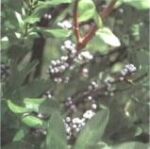| Common Name: |
Bayberry |
| Other Names: |
Wax Myrtle, Candleberry |
| Botanical Name: |
Myrica cerifera |
| Genus: |
Myrica |
| Family: |
Myricaceae |
| Native Location: |
SE USA |
| Cultivation: |
Well-drained to wet, acid, sandy soil in sun or partial shade. Myrica gale prefers permanently wet conditions. |
| Propagation: |
By seed sown when ripe; by layering in spring; by suckers (M. gale); by semi-ripe cuttings in summer. |
| Harvest: |
Whole plants or leaves are collected during the growing season; bark and root bark in late autumn or early spring. All parts are dried for decoctions, infusions, liquid extracts, and powders. Fruits are gathered when ripe for wax extraction. |
| Height: |
3-12m (10-40ft) |
| Width: |
5m (15ft) |
| Hardiness: |
Z8-9 |
| Parts Used: |
Leaves, shoots, flowers, bark |
| Properties: |
A bitter, pungent herb that has diuretic and rubefacient effects, improves digestion, and prevents and treats formation of stones in the kidney and bladder. |
| Medicinal Uses: |
Internally for urinary tract infections, urinary problems associated with prostate enlargement, kidney and bladder stones, gastritis, poor appetite, fevers (bark); obesity, rheumatism (leaves). Externally for rheumatism (leaves). |
| Culinary Uses: |
Leaves and young shoots are cooked as a vegetable. Flowers are pickled. Berries and seeds are also edible. |
| Bibliography: |
Encyclopedia of Herbs by Deni Brown Copyright © 1995, 2001 Dorling Kindersley Limited. pp 182-183 |

